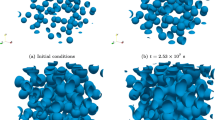Abstract
A model of the formation and growth of gas-filled pores in the cores of absorbing elements under neutron irradiation is described. The model is based on a definite similarity between the mechanisms of radiation damage in boron carbide and oxide fuel. For boron carbide, the key mechanism is radiation-stimulated coalescence of helium bubbles, which gives rise to the much larger swelling of boron carbide as compared with nuclear fuel. Regimes of the coalescence of helium bubbles as a function of the irradiation intensity, neutron spectrum, and radial position are investigated. It is shown that the model describes qualitatively well the basic development of gas-filled porosity under irradiation in fast and thermal reactors.
Similar content being viewed by others
REFERENCES
V. A. Solov'ev, A. A. Demishonkov, M. N. Meshkov, and E. N. P'yankova, “Physical, mechanical, chemical, and radiation properties of boron carbide,” Preprint FÉI-2807 (1999).
I. A. Evdokimov, S. Yu. Kurchatov, V. V. Likhanskii, et al., “Analysis of physical processes influencing the dynamics of structural changes during irradiation of the absorbing elements with boron carbide in thermal reactors,” Preprint TRINITI-0089-A (2002).
V. D. Risovanyi, E. P. Klochkov, A. V. Zakharov, et al., “Status of the problem of absorbing materials and control rods for various types of nuclear reactors,” in: Report at the 4th Interdepartmental Conference on Reactor Materials Engineering, Dimitrovgrad (1996), Vol. 4, p. 3.
V. B. Ponomarenko, A. V. Shcheglov, A. O. Poslavskii, et al., “Analysis of the results of service life tests of various absorbing elements in the safety and control rod system of a VVÉR-1000 reactor in the No. 5 unit of the Novovoronezh power plant and subsequent tests of spent parts,” ibid., p. 19.
V. D. Risovanyi, A. V. Zakharov, E. P. Klochkov, et al., “Post-reactor materials engineering investigations of an absorbing element in the safety and control rod system of VVÉR-1000 reactors,” in: Report at the 5th Interdepartmental Conference on Reactor Materials Engineering, Dimitrovgrad (1996), Vol. 1, Pt. 2, p. 100.
J. A. Turnbull and M. O. Tucker, J. Nucl. Mater. (1974).
V. V. Likhanskii and O. V. Khoruzhii, “Models of the production and behavior of gas bubbles in irradiated nuclear fuel,” Preprint TRINITI-0042-A (1998).
R. White and M. Tucker, “A new fission-gas release model,” J. Nucl. Mater., 118, 1–38 (1983).
J. Dines and J. Vineyard, Radiation Effects in Solids [Russian translation], Izd. Inostr. Lit., Mosow (1960).
I. S. Grigor'ev and E. Z. Melikhov (eds.), Reference Data on Physical Quantities, Énergoatomizdat, Moscow (1991).
B. V. Dobrov, V. D. Kanyukova, S. Yu. Kurchatov, et al., “Simulation of radiation blocking of the intergrain boundary and the influence of this effect on the escape of gaseous fission products from UO2,” At. Énerg., 88, No. 6, 445–453 (2000).
P. G. Cheremskoi, V. V. Slezov, and V. I. Betekhtin, Pores in Solids, Énergoatomizdat, Moscow (1990).
D. Simeone, D. Gosset, D. Quirion, and X. Deschanels, “Study of B4C microstructure evolution under neutron irradiation by x-ray diffraction profiles analysis,” J. Nucl. Mater., 264, 295 (1999).
G. Hollenberg and W. Summings, J. Am. Ceram. Soc., 60, 520 (1977).
G. Coperland, R. Donnelly, and W. Martin, Nucl. Techn., 16, 226 (1972).
I. M. Lifshits and V. V. Slezov, Zh. Éksp. Teor. Fiz., 35, No. 2, 472–492 (1958).
Author information
Authors and Affiliations
Rights and permissions
About this article
Cite this article
Evdokimov, I.A., Likhanskii, V.V., Sorokin, A.A. et al. Model of the Formation and Growth of a Gas-Filled Cavity in Boron Carbide under Irradiation. Atomic Energy 93, 749–758 (2002). https://doi.org/10.1023/A:1021724201310
Issue Date:
DOI: https://doi.org/10.1023/A:1021724201310




